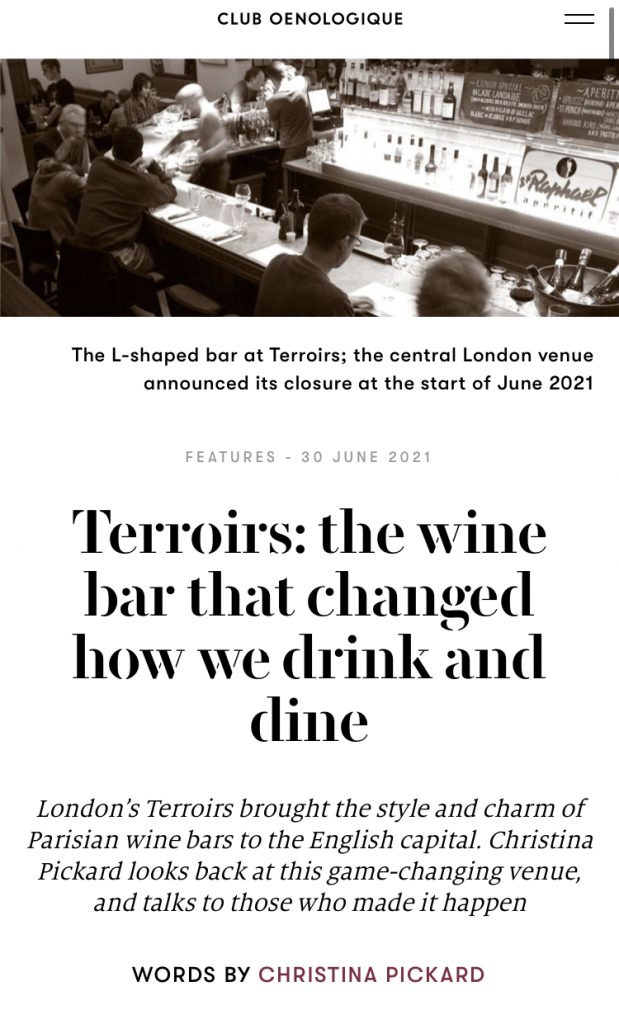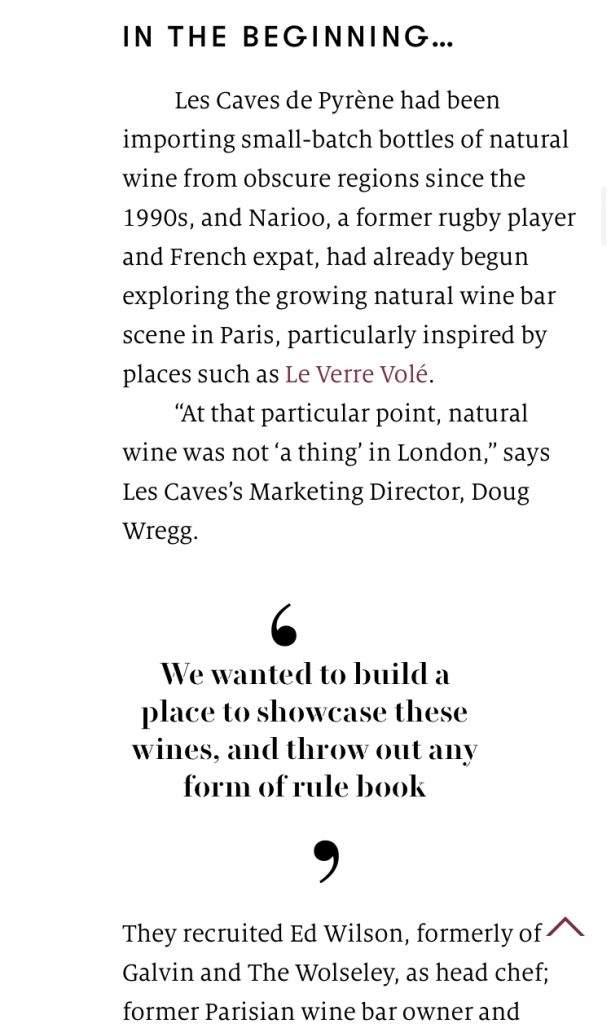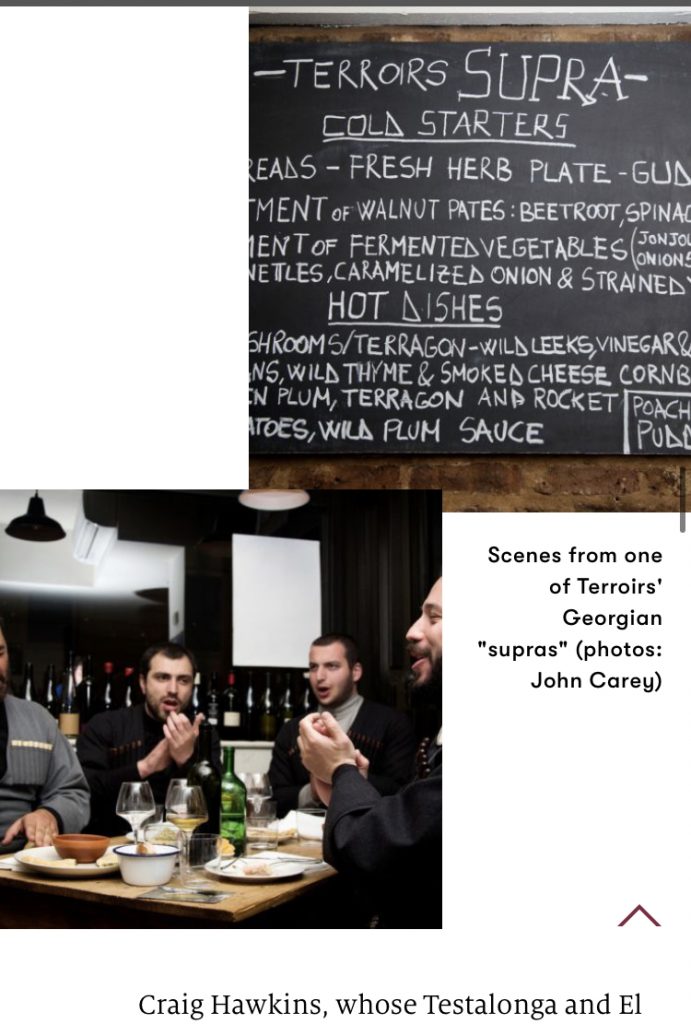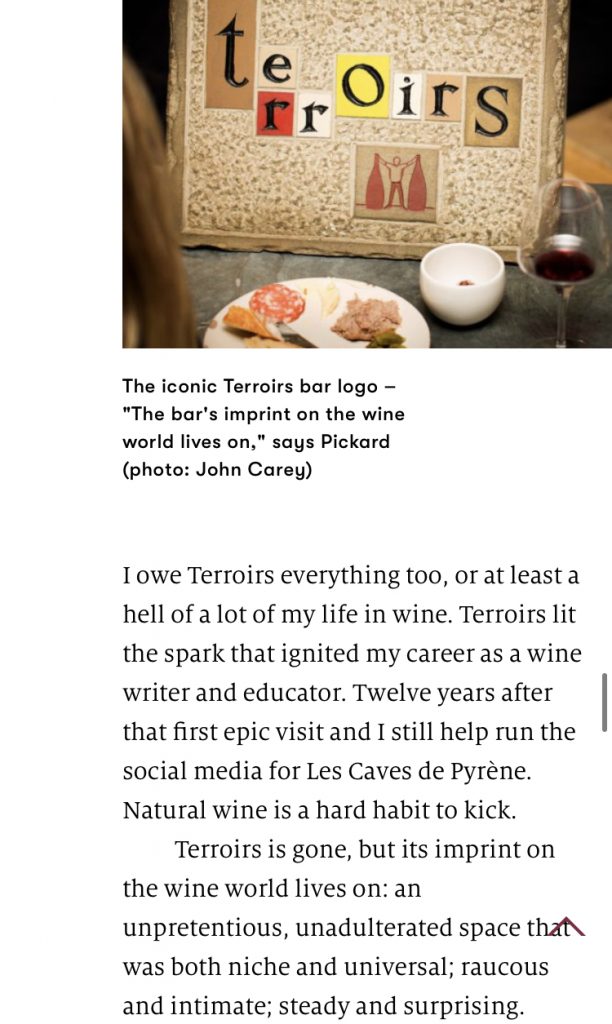Wine writer Christina Pickard, who helps run Les Caves’s social media, recently wrote an article about our beloved and recently shut Terroirs Wine Bar for the publication Club Oenologique. In the process of writing, she collected numerous stories and anecdotes from some of the people most impacted by Britain’s first natural wine bar. Due to space constraints, most of their words had to be cut from the final article, so we have printed them here in the hopes of keeping Terroirs’s memory alive in the hearts and minds of all of us who love who loved this special space.
(You can also keep it alive by visiting Terroirs’s sister bars, Terroirs East Dulwich and Soif!)
Read the full article here, then get a deeper dive below.
Terroirs memories:
“I met Eric and Doug back in ’95 when they supplied me at The Fat Duck. Heston and I had always wanted to champion the small producers from the unheard of places, remembering that this was way before the internet and most of our education came from The Vine or Parker’s journals, so it was a blessing finding them or them finding us.
When Les Caves brought wines into gastronomic restaurants back then, the wines were at a disadvantage, having so much personality they were brushed off by sommeliers, in a sort of ‘too hot to handle’ way, or if they weren’t in the journals with a stamp of authority already on them they were deemed risky – not coming from that background we were opened minded and started working with them.
By the mid Noughties, I was fully aware of Eric’s vision and what he wanted to achieve and when Ed Wilson came onboard as Chef it became obvious to us what to do and that was build a place that showcased these wines and throw out any form of rule book – a sort of revolution happened.
I don’t think we had any idea how big it was going to be, but I think Eric had an inclination.
The site had no extraction for a kitchen, and as it was in Coutt’s bank, we weren’t allowed to go into their space, so the only solution was to put the kitchen into what was previously the gents toilet, which was tiny. That small space dictated to Ed that everything would have to be on small plates and leave the kitchen when they were ready as there was room to collate them, necessity the mother and all, showed Ed the way.
In truth the food was so well received it made the wine bar, here is an original format menu
The budget to open Terroirs was negligible- we talked about timber floors and a big bar, but everything apart from the big bar which was nonnegotiable was forgone, as Eric said stood on the old concrete floor in the basement “well, it works, I suppose”.
We collected brick a brac from fairs in France, the banquettes were out of Marco’s Mirabelle, the silverware was old breakfast service from Le Manoir and the art from friends.
The day we were emptying the site we had a truck putting all the “new” secondhand furniture in, and taking away the old, our accountant, sitting in the window, said ‘how do you know what’s the right rubbish and what’s just rubbish, this is chaos’ – and so it began.
There was nothing else like it, it had the laissez faire attitude of Paris bars, but a strong discipline of London and I think that’s the difference between the two Cities.
We were fast – Ed was fast. It took less time to get a plate of Charcuterie than a glass of Beaujolais, so we learned to set up service to deliver the tempo and we did 300 to 400 covers a day.
Other restaurants like Boca di Lupo followed and later Polpo, 28-50, Sagar and Wilde, but nothing wore its own skin as comfortably as Terroirs. It was real, it seemed to mean it and the guests felt part of it whether they were in a suit or jeans and flip flops. It wasn’t a movement, it was for everyone and we communicated differently.
Terroirs has normalised natural wine and [today] they feature massively in gastronomic restaurants, with sections on orange and skin contact. Even Le Manoir major on natural, biodynamic, organic and sustainability runs through their list.
I think that’s remarkable remembering how it originally got buffered.
—Nigel Sutcliffe, restaurant consultant at Truffle Hunting + former CEO of the Fat Duck group.
*
“I remember Doug [Wregg] showing me a series of Chenin Blancs at Terroirs in 2011, encouraging me to explore the variety more. The bracket also included a pet nat, something I’d never heard of before. I immediately produced a pet nat the following year in 2012, Australia’s first wine labelled so…Of course when I started offering the pet nat for sale, it was adopted slowly. Wow, how things have changed! That pet nat led Alwin Jurtschitsch to my cellar from the Kamptal in Austria. He returned home to begin making pet nats under his label]Fuchs and Hase with his buddy in his shed. Jonas [and Daniel] Brand from Pfalz in Germany were then inspired to make pet nat, a style their Brand label is now celebrated for. So Doug and Terroirs have played a huge role in this domino effect.” —James Erskine, Jauma Wines, Australia
*
“I have know Doug and Eric for quite some time. They were the early adopters of the natural wine appreciation and you could see that in their enthusiasm and smile and the glass in hand. The staff always appeared happy and energised. After nearly four decades of wine growing according to the biodynamic principles, I thought my opinion on wines was quite broad, albeit my training with the masters was back in the ‘70s. When I enjoyed the initial qualities of Doug’s generosity it was a rather sour tasting cloudy wine from some unknown region in the south of France. It was shocking yet it hit a pulse. It was unforgettable, so I went back. Each time I would return to London when putting leather on pavements, instead of boots on the rooftops of other kingdoms, I would always desire to take lodgings nearby Terroirs if only to shorten the route to my next experience of enlightenment. In those early days I don’t believe New Zealand as a wine producing country was that embracing of the style of wine Terroirs was seeking. And even these days for us to even get export approval for such wines is a pathway of egg shells and a game changer for those academic winemakers who may sit on the selection panels. Thankfully these obstacles are changing here due to the international demand of which Terroirs were to game changers. I was chatting with a colleague in Paris a year or two back and commented that I understood there to be 19 natural wine bars. She responded very acutely that there were in-fact over 220 such bars. And the same goes for every major city in the world these days.” —James Millton, Millton Vineyards and Winery, New Zealand
*
“Terroirs has always been a reference in the London natural wine scene and known by people around the world as one of the best destinations in the city to drink natural. It has definitely evolved over the years, with our customers’ perception of natural wines constantly changing. Natural wine still is fairly abstract for most, but the proportion of guests not knowing about it is constantly reducing. It doesn’t mean that everyone enjoys it of course, but people nowadays have at least heard about it, which has made it easier for our team to introduce them to guests visiting us and unfamiliar with those wines.
London is one of the most exciting cities for natural wine drinkers in the world, and I want to believe that Terroirs, through our owner Eric, has played a key role at first.
The buzz around this place was incredible, and there are countless tales about the place being packed from opening to close, with people excited to discover and experience what Terroirs had to offer, late nights and crazy dinner services.
Many people worked at Terroirs over the years, and ended up going on to create or launch their own business, which eventually led to what the current scene looks like. This was not an easy task, especially back in the days where wine in the UK was restricted in people’s mind mainly to grape varieties, as opposed to a certain type of wine and their locations, people, terroirs etc. Terroirs and Eric, through Les Caves de Pyrenes, I believe, helped a lot in shaping up people’s mind around the idea that wine is about Terroirs, more than single varietals bottles.
The closure of Terroirs is definitely a big loss for the local natural wine scene, but I am hopeful that many other bars will thrive and flourish once this difficult period has passed, and I am looking forward to seeing what it has become in the next 5 to 10 years.” —Benjamin, Terroirs Operations Manager 2019-2021.
*
“Terroirs was chaotic! And that was precisely why I loved it. I’d worked at loads of restaurants by the time I landed at Terroirs and many felt formulaic, generic. Terroirs was so different, so alive and full of passion. Having no previous knowledge about natural wine, I was immediately intrigued by the cloudy, glowing glasses I saw being passed over the bar. It was the first time I was introduced to people who really cared about produce and its provenance, both for the wine and the food… it was entirely contagious.
It seems funny now, as this has become the complete norm for restaurants but really at the time it was an exception. At that time there was next to no natural wine scene in London: you could count the places on one hand. Again, that seems crazy as now it’s everywhere! It was a pretty open-minded clientelle at that time: a lot of people came for ‘the experience’ and were happy to try new and different things. There were, of course, the inevitable ‘this wine tastes like cider’ or ‘it smells like a farmyard’ but people were generally open.
I was so sad to hear that Terroirs won’t reopen: I have such magical memories from those years: hectic services, wild wines, full belly laughs and so much terrine. It gave me friends I have still (not to mention my boyfriend, Max, who had been a manager at Terroirs and had just left to open Brawn!). Terroirs gave me my knowledge of and thirst for wine, real wine. It gave me an immense appreciation for the work involved in creating, cooking and serving beautiful produce. It introduced me to some of the most brilliant, wild, humble, honest people I have ever met.
It was the spirit of Terroirs, drinking wines which changed my perception of what wine was, and meeting the amazing growers responsible that inspired me to produced my first ‘wine prints’. I’d recently graduated from a print design degree and during my time at Terroirs I produced a series of prints based on the Paris ’68 student uprising movement, but bent towards the natural wine movement: La Lutte Continue becoming La Goutte Continue. Solidarité avec les Travailleurs to Solidarité avec les Soiffards and, of course, Terroirists. I made a special print for the opening of Soif and exhibited at the Real Wine Fair. When The Green Man and French Horn (the Loire-based sister restaurant) opened round the corner, I designed the wine list, adding lots of visual bits and bobs. After that wine just sort of naturally (pun, ha!) became the focus of my work: I constantly find new things that intrigue me about it and I owe a huge amount to Terroirs for sparking this unfiltered, unfined passion.” —Louise Sheeran, louisesheeran.co.uk
*
“I met Eric Narioo at a film premier in Soho were I was pouring some wine in 2011 he invited me for a lunch the next day at Terroirs: the range of wines, their colors, there textures, aromas, flavors through my mind into a rainbow! I was making qvevri wines with indigenous varietals from Georgia working naturally but knew quite little about that natural wine scene, then ended up at a lunch that rocked my world. Eric and I became friends. He came to Georgia we introduced him to growers. A few weeks later we went to the Real Wine Fair. Immediately after, he took myself, Gela my partner at Pheasant’s Tears, and Friar Gerasim from Alaverdi Monastery on an epic wine adventure across Europe culminating with installing Qvevri at his and Anna’s domaine on Etna. On that trip we met many wonderful and inspiring growers. At Terroirs over the years we hosted guests, organized pop ups cooking Georgian food, singing Georgian songs…Terroirs was a portal of cultural exchange a meeting place for lovers of natural wine and a place Georgians could share their juice with the outside world. The wine bar and the people behind it changed our lives professionally and personally; a trampoline of life. —John Wurdeman, Pheasant’s Tears, Georgia
*
“In 2010 I had my very first ‘business meeting’ [at Terroirs]. Looking back I was really clueless and nervous. I don’t get nervous in general but when Doug, Eric and Phillippe agreed to meet me and taste my wines for the first time…It all happened at the first table as you come in[to the bar] on the right, next to the door. I remember clearly walking through and meeting Florian Perate, whom I shared a mutual friend with, and he was so relaxed and nice to me that I just knew the meeting with the Les Caves team would go well. I tasted my skin contact 2008 and 2009 and Cortez 2009 with them. I will never forget after them tasting the wines. Eric and Phillipe’s faces (like a stone wall) and Doug constantly looking at them for their thoughts. They then smiled and asked me how much per bottle. I hadn’t thought about that part yet! So I just picked a nice round number, and they said ‘ok, we will take it’. And that was that.
After that moment I was welcomed into the Les Caves family and all my doors opened for me. My best memories were made at Terroirs. Later that year in 2010, I was still working for Lammershoek then, and was on a trip for them with Carla. I arrived at Terroris at 12:30 to meet Doug—and this is where I will be forever grateful to them—he opened up so many wonderful bottles of wine, things I had never tasted before; key bottles were Dinavolino and Dard et Ribo but it was a 2009 bottle of Mauvais Temps (Carmarans) that blew me away with its fruit purity,tannin and refreshing alcohol. It was after that that i knew what kinds of red wine i would like to make.
I left terroirs at 18:30, ‘happy to say the least’, and arrived an hour late for my tasting (luckily Carla was there) but I just couldn’t escape the memories of the wines I had tasted and how different they were to anything else I had been drinking, ideas were running wild.
But one of the fondest memories was the first Georgian Supra held at Terroirs. I was on my own and arrived at the bar not knowing what to expect. I was fascinated by what the Georgians were doing, but more so by their “emotion to wine”. It was unlike anything else I had experienced before, and I have drunk with some pretty passionate Frenchman! By the end of the night when they started singing, I will never forget that moment, it silenced the whole bar/room and everyone was in tears after. I haven’t seen anything quite like that before or after. The first time is always the most special. Just drinking with the monks from the Georgian monastery; we lead two completely different lives and couldn’t speak any common language but we could understand each other that night.
All of the parties I have attended there were like a big family party, and engaging with all the wine growers from around the world was just incredible. In the early days it was more with the European growers but later on as more New World producers got involved it was amazing and the transfer of knowledge that happened in that room; it must have been something unlike most other places in London.
I will miss those long nights were Tom Lubbe (Domaine Matassa) and I would share stories and make jokes; special days that I will never forget.” —Craig Hawkins, El Bandito/Testalonga, South Africa
*
“Terroir has been the mothership for natural wine in London. It was a bit [like] the school of life for me. It gave me my first wine goosebumps and made me enter a very unique world of passion, human[s] and grapes.
Terroirs [brought] everyone together: winemakers, wine people, consumers & customers.”
I was working on Naughty Piglets when I started at Terroirs and had a very clear vision of what I wanted Naughty Piglets to be. Terroirs taught me so much about wine, from winemaking to [an] understanding of my own palate, but also an understanding of other people’s palates. And mainly what it meant to make real wines, from the vineyard to the cellar.
I’ll never forget sitting at the bar drinking my first bottle of Ganevat (J’en veux 2012), having goosebumps and not being able to speak for ten minutes! I was literally hit by a crazy emotional wave and I guess that was it for me, I knew exactly where I was going.” –Margaux Aubry, Naughty Piglets/The Other Naughty Piglet
*
“I remember a feeling, at the time, that can be summed up in two words: joyful and delicious. It felt like a place for discovery, with enthusiasm about new tastes, whether new bottles or nice ways to swing food. No chapel and no pretense, more like a freshly opened window.” —Remy Charest, French-Canadian wine writer/educator
*
“Terroirs changed the perception of natural wine in the UK . In the way that Ten Bells did in NY or Bar Brutal [later] did in Barcelona. The UK market had been very slow to pick up on natural wine, dominated as it was by ‘Classical’ wine-loving crusties. Terroirs took the Parisian natural wine bar/restaurant spirit and translated it into London. Part of the English market finally understood what all the fuss was about. All thanks to Eric, Doug and Les Caves!’ –Tom Lubbe, Domaine Matassa, France
*
“I had known Eric on and off since about 2003 as a cook in London. I was Head Chef of The Wolseley restaurant. When it came to doing the wine tastings, the [staff] invited all of these amazing wine importers, and everyone else showed up in their suits with briefcases and their wines and then Eric turned up in his usual t-shirt with a hole in it like a hessian sac and with a chunk of cheese, bread and charcuterie and a knife. And he proceeded to cut all these different bits and then open the wine. I was tasting these wines for the first time and I really connected to them. The idea of Food and Wine rather than always seeing it as two separate things. That was when most restaurants operated where the Head Chef writes a menu. The [Head Sommelier] writes a wine list and they rarely interact with each other.
I was sort of in between a number of jobs where I was trying to find the right thing. And then I think Eric actually got in touch with [my former employer] Chris Galvin and said, ‘I’m thinking of doing this Terroirs thing’ and would he recommend anyone’ and Chris said, ‘Yeah, Ed’.
And it was the right time, so to speak. I really wanted to take ownership of something and drive something for myself as opposed to work for someone else, and I think that relationship, even to this day, we still thrive we still enjoy that partnership.
The site itself was a bit of a dead spot in Covent Garden. It was on a back end street that nobody really walked. The space itself was slightly awkward. It’s a big space but there was two floors. We did it on a budget, it wasn’t elaborate. We just tried to do something as simply as possible. But much of it wasn’t it wasn’t ever planned. We were so limited with the space we had in the kitchen. We had no gas or electricity, we used induction. We had this tiny little pocket in the kitchen where I kind of pushed three chefs, and we ran a menu of seasonal cooking. It was French focused, my background being sort of French classical in terms of how I used to cook. And I think we coined the term small plates, which I don’t think existed in the UK before Terroirs. We drove the concept of ‘British tapas’ and proceeded places like Polpo.
Terroirs became an industry hang out. It was a place where industry people went out. We had a roll call of chefs visit over those first couple years, everyone from Heston Blumenthal to Michel and Albert Roux, from Pierre Koffman to Gordon Ramsay — all the classic chefs. It was definitely a place for all the industry to share food and wine and be boisterous and noisy. It didn’t conform to the traditional restaurant format. I think that [lack of conforming] in itself wasn’t planned. Even the menu itself, which became a signature of the restaurant, was the placemat. Three hours before the first service, there were no menus on the table. I said I would just write it on a piece of paper on the table and then somebody said, well, why don’t we just make it a placemat. It was all those things. But there was no sort of big plans, what it was just sort of happened.
Everyone who worked there knew the reactions [of customers trying natural wine for the first time]. I mean, I wish we could’ve recorded them. They were beautiful, some people’s faces. This was a constant for a good five years. Even when we opened Brawn in 2010 there was still a lot of work to do in terms of communicating to people about the wines and how they were made, why they stood out, why they were different. Move forward to 2021, and we can sit back some now. You don’t have people coming in needing help to choose what they want to drink, they know what natural wine is. There’s so much less conversation about natural wine. It’s gotten so much easier and I think that’s not only in London. (Ed is opening a restaurant bar in Margate, on the coast of Kent). There’s a huge culture of music and artists and independently owned restaurants now [all across the UK]. And it’s probably only in the last 10 years that the focus is all natural so that is down to the work Terroirs has done.
I think it’s nice to hold on to the memories of it now; to have these moments now where you reflect on the impacts of what the restaurant has done – the number of people that have gone through that business and gone on to create restaurants and wine bars of their own; they’ve become wine importers. You know how many winemakers who came to those doors tried wine and it changed the way they made their own wine?
The legacy is huge.”
–Ed Wilson, former Head Chef of Terroirs, currently at the helm of Brawn.










Pingback: The UK Natural Wine Scene: Ten Years On – Les Caves de Pyrene